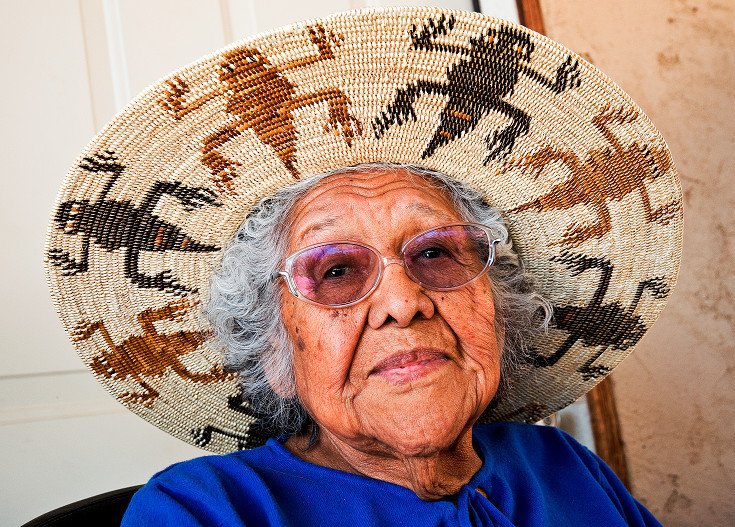951-849-4527
director@wiefelsmortuary.com






Obituary of Katherine Siva-Saubel
When she was 18, Katherine met Wanikik Cahuilla Mariano Saubel at the last Cahuilla ceremonial gathering, on the Palm Springs Reservation. She noticed him right away across the fire, and told her girlfriend next to her, "I'm going to marry that man." She asked her nephew, Robert, who Mariano was, and Robert introduced them. They spent the rest of the ceremony in the kitchen, talking the night away. Two weeks later, Mariano borrowed his father's car to take her out. They dated for two years, and had to wait for permission to marry because one of their elder relatives thought they were too closely related (by Cahuilla standards) to get married. Finally, her father told her that it would be okay, and that they were not too closely related.
In 1940, at the age of twenty, Katherine married Mariano Saubel, who lived at the Morongo Reservation near Banning (where both Mountain and Pass Cahuilla were spoken, as well as the distantly related Serrano language). Katherine describes Mariano as a very loving and gentle man, who loved animals and children, saw two sides to every story, and did not speak badly of others. Just one year and a half after they were married, Mariano was drafted for WWII. Their son Allen was born just before Mariano was sent overseas in 1943; luckily, he was able to take a little time away from training to come home and meet his son before being deployed to serve in North Africa and Italy. He was gone for three years; Katherine wrote him every day. She spent most of her time taking care of Allen and working their small family farm and orchard with her in-laws. As Katherine puts it, she "worked like a man" with her father in law, and learned the hard way how to drive a tractor and irrigate the crops. She enjoyed it more than cooking, housework, and basket weaving, which she says were never her strong points. Mariano's mother was a well-known Cahuilla basket maker, and she watched the baby while Katherine worked in the fields and orchards.
Mariano and Katherine Saubel were married for forty-five years, until Mariano Saubel passed away in 1985. Allen was their only son, but they also helped raise his four children, as well as nieces and nephews. Mariano was extremely supportive of Katherine's work to preserve Cahuilla and other Native cultures, and worked with her to found and build the Malki Museum.
In 1958 Katherine was introduced to Lowell Bean, who was then a student of ethnology and anthropology at UCLA. This began a forty year collaboration on Cahuilla culture. Lowell Bean is a man as remarkable as Mrs. Saubel in his own way, for Dr. Bean has managed not only to become an eminent scholar on the Cahuilla (Bean 1969, 1972, 1972, 1989), but has also become a lifelong friend of Mrs. Saubel's. One need only observe Mrs. Saubel and Dr. Bean interacting for a short time to understand that theirs is not a distant, predatory relationship between Indian informant and academician, but rather a friendship built on mutual respect. Soon after they met, Dr. Bean introduced her to Dr. William Bright, Professor of Linguistics and Anthropology at UCLA. Her life began to change - her formal education had begun.
She entered willingly into the new world of academics, and became a catalyst for sharing and learning in the academic surroundings of universities and museums. Mrs. Saubel realized that the Cahuilla were in danger of being completely engulfed and forgotten by the dominant English speaking society which surrounded her people. She resolved to make it her life's work to help document the Cahuilla culture and language before it was too late.
The Kennedy Scholarship for Native Americans in 1962 allowed Katherine (at the age of 42) to travel to the University of Chicago and the University of Colorado at Boulder, where she studied the fundamentals of ethnology, anthropology, and linguistics. She then began giving seminars and study groups at UCLA under the direction of Dr. William Bright.
Together, Dr. Bean and Mrs. Saubel (1972) authored Temalpakh, a monumental yet easily readable work detailing the ethnobotanical knowledge of the Cahuilla (much of the information comes from Mrs. Saubel's mother, who was a Cahuilla medicine woman). Dr. Bean and Mrs. Saubel continue to be involved in anthropological scholarship on the Cahuilla.
Katherine Siva Saubel has since become known internationally as a Native American scholar and appears in the biographical Reference Encyclopedia of the American Indian (1967) and many other biographical reference works.
She is a forceful communicator, acclaimed public speaker, and activist in matters of Indian rights. Katherine has brought her talents to bear on public forums, universities, TV, films, and radio. She has traveled and lectured widely, including places like UCLA, California State University Hayward, UC Riverside (where she served as Regent's Lecturer during the spring of 1990), the University of Cologne, Germany (where she conducted seminars for anthropology students in 1971), and the Hachinohe University in Japan in 1997. She has traveled to Germany (1971, 1991), Japan (1997), and New Zealand (2002). She also spoke at UC San Diego in 1994 for American Indian Youth Motivation Day.
Katherine has served as member and chairwoman on the Los Coyotes tribal council for many years. As a leader of her people, Mrs. Saubel has worked tirelessly on many important issues - the preservation of sacred sites, prevention of hazardous waste disposal on Native Reservation lands, reburial of Native bones and sacred artifacts to maintain the sanctity of ancient burial grounds and sites, and testifying before the U. S. Senate, the California State Assembly, and other government agencies and committees. Her skill in bridging differences and in negotiating solutions to problems is tempered by a sense of humor and wisdom.
She has also served as a member of the Governor's California Native American Heritage Commission and has been active on many fronts concerned with preserving California Indian culture and historical sites. Her work on the commission has brought attention to the cultural resources, the sacred sites, and the need for an amendment to the religious freedom act. She is proud to have reburied many ancient remains in the sacred manner, with the ancient and sacred Cahuilla birdsongs.
She has worked with many noted anthropologists and linguists, including Professor Lowell Bean, and Hansjakob Seiler (a German linguist), who with her assistance published two studies of the Cahuilla language. She also worked with Japanese linguist Dr. Kojiro Hioki, from the Hachinohe University. Drs. Seiler and Hioki worked together with her to publish an updated book on the Cahuilla language in 2006.
Her published works include Temalpakh: Cahuilla Indian Knowledge and Usage of Plants (1972) with Dr. Lowell Bean; Cahuilla Ethnobotanical Notes: Oak with Dr. Lowell Bean (University of California Archaeological Survey Report, 1962); Kunvachmal: A Cahuilla Tale (The Indian Historian, 1969); Cahuilla Ethnobotanical Notes: Mesquite and Screwbean, with Lowell Bean (University of California Archaeological Survey Report, 1968); I'Isniyatam (Designs) a children's book, 1980; and editorials in the Journal of California and Great Basin Anthropology.
Overall, Katherine awakened interest in the Cahuilla language, not only in the universities and with foreign scholars, but also with young Native Americans. Mrs. Saubel's ability to stand by her beliefs and heritage when challenged by different factions of tribal government or private interest groups is almost legendary. She blends hard work and fierce determination with wonderful laughter and kind words to those in need. Her innate ability to interact with people of all walks of life and her openness to the achievements of others carry the marks of a great woman. She has been able to influence and inspire others around her, and encourages honor and respect for nature and tradition. Her recognition of the different parts men and women played in the preservation of cultural and spiritual life has also made her a most effective and valuable representative of her people.
Her achievements and awards are numerous:
She co-founded the Malki Museum with Jane Penn in 1964, and has served as its President to this day.
She appeared in the movie "Tell Them Willie Boy is Here" with Robert Redford and Robert Blake in 1969 as a minor character.
In 1971 and 1991 she traveled to Germany to help Dr. Seiler with his linguistic work on the Cahuilla.
She served for over 14 years on the Riverside County Historical Commission, and in 1986 that group named her County Historian of the year for her many contributions to local history. She also received awards for outstanding achievement and distinguished service as a member.
She was named the Elder of the Year by the State Indian Museum in Sacramento in 1987.
She has translated Cahuilla oral literature into English for presentation on National Public Radio (around 1989).
She received the Honored Elders Award in 1993 from the California Indian Health Board.
She was a member of the Coachella Valley Archaeological Society from 1989-1993.
In 1993 she was inducted into the National Women's Hall of Fame as the first Native American woman from California.
In 1994 the National Museum of the American Indian in New York gave her one of their first awards for cultural achievement.
She was honored locally as the Stagecoach Days Grand Marshall in the city of Banning in 1994.
The YWCA named her a Woman of Achievement for notable achievements in preserving the culture of Native Americans also in 1994.
In 2002 she received an honorary doctorate from La Sierra University in Humanities and Philosophy.
She traveled to Japan in 1997 and lectured for Dr. Kojiro Hioki's linguistics class at the Hachinohe University for a month.
In 2002 she received a Lifetime Achievement Award from the Costanoan-Ohlone Rumsen Carmel Tribe, at Mission Dolores, San Francisco, CA.
In 2002 she received the Chancellor's Medal from UCR, signed by Senator Jim Battin. This is the University of California's highest honor.
She has been asked for help in identifying baskets and artifacts from institutions all over the world, such as the Smithsonian, the Peabody Museum in Boston, and the ________ Museum in Berlin, Germany in 1991.
She has worked actively for decades with local, state, and national organizations, and has testified repeatedly before the Senate Select Committee on Indian Affairs, chaired by Senator Inoya. She has been recognized in her own Riverside county, as well as by the CA state senate and assembly for her achievements.
In summary, she has helped others to discover the culture and heritage of her own people, and has worked diligently to bridge the two worlds. In her own words, "Nobody wanted to know we were here. We were swept under the rug by non-Indian people who felt guilty about what had been done to us. So we were just a forgotten people, and now we can say we are still here and were here a thousand years ago."
Now, at the age of 87 years old, Mrs. Saubel is not retired like many her age, but with the help of others continues to travel all over the country and labor towards cultural preservation. She also still serves in her capacity as Malki Museum President, and has no plans to stop until she is unable to do so.
We have here the amazing and inspiring story of a woman who would stand out as exceptional no matter what her cultural background. Let us not forget what she has worked so hard to preserve.





